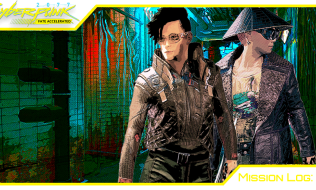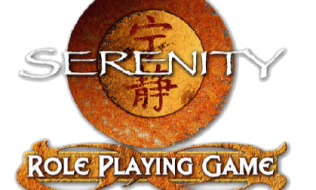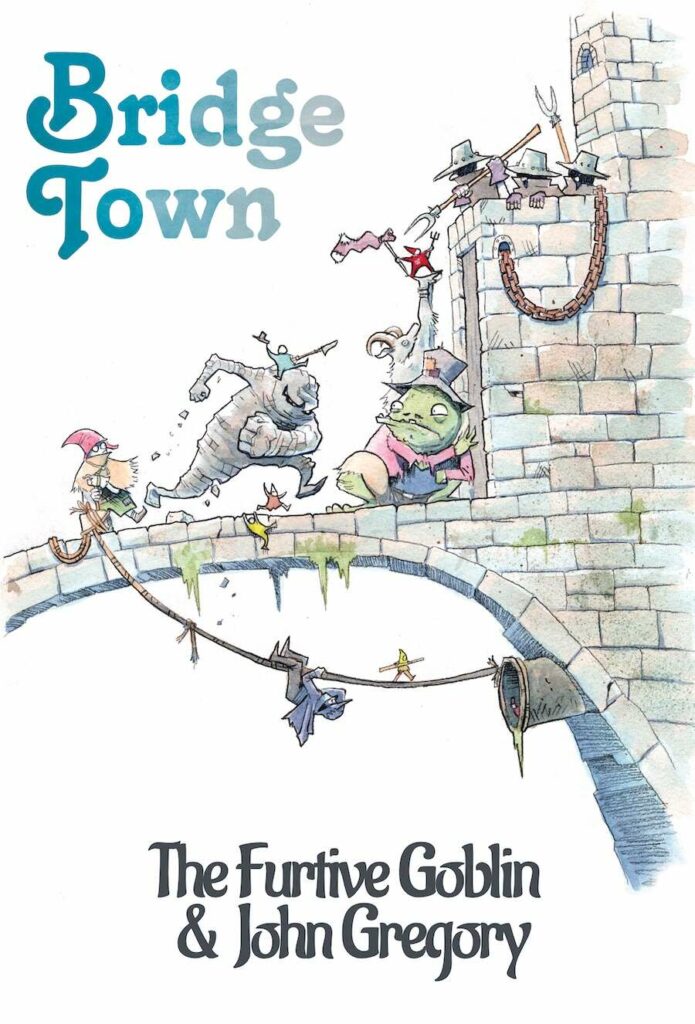Obsidian Portal Campaign of the Month January 2024: More Things in Heaven and Earth

Get ready to jump into the mystical techno-magical future of North America after “the Awakening”. The year is 2082. The place is “The Emerald City”, where people are willing to risk it all and walk on the bleeding edge, making deals with anything. The GM is Dropbeartots. The runners are a rag-tag group of humans, an elf, an ork and a troll. They adventure in a Sixth World Shadowrun game called More Things in Heaven and Earth.
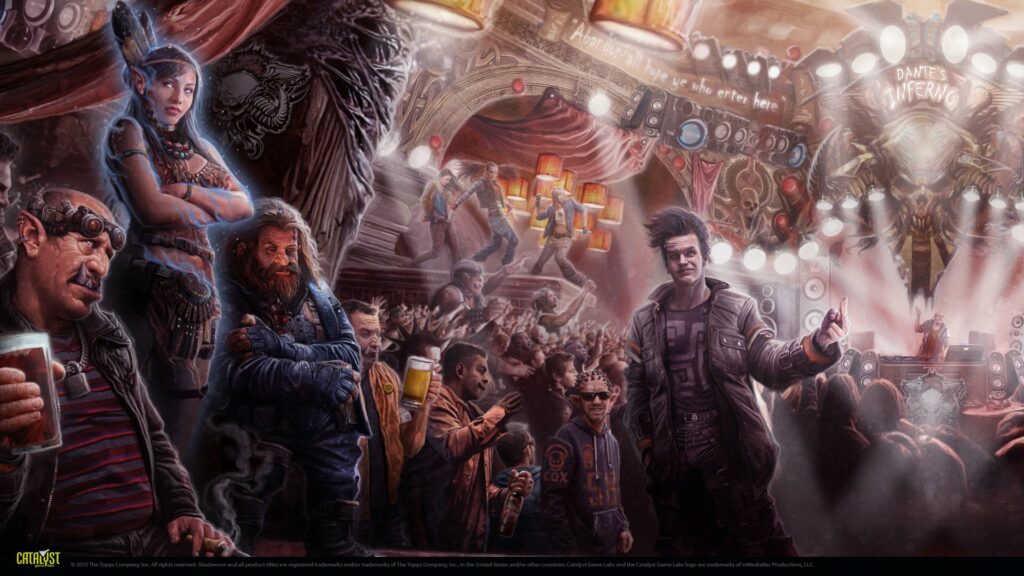
First off, feel free to tell us about the person behind the GM screen. Where are you from? What do you do aside from gaming? Alter Egos? Life partners? Family? Where can we interact with you on the internet?
I’m just an Immortal elf hanging around waiting to see the Awakening happen still! My alter-ego is a dropbear, of course. My folks were military, so I really didn’t settle down anywhere for very long until my Dad retired. Since then, Ive been in Texas. Aside from gaming, I work a lot and try to make enough money to keep up with Shadowrun’s new releases and increase my collection of older edition books. Two of the gamers in my group are related to me: Ringpop is my wife, and Nomad is my youngest son. My internet activity has decreased quite a bit in the past few years, but I have a neglected site on WordPress called When Dropbears Attack! I really should get back into it…

You are running a Shadowrun Sixth World Game. Are you familiar with the previous editions and if so, can you mention any differences, or talk about the evolution of the Game? What are the things you most enjoy about the Shadowrun world in general?
Shadowrun has been the single game that’s really carried my interest across all editions. I’ve been the forever GM with it since first edition came out! The most captivating thing for me about it has been the evolution of the story of the Sixth World across the decades, and the back cover blurb of the first edition core rulebook just grabbed me more than any other game ever has. It has always been a game about three worlds – Man, Magic & Machine – that kept me engrossed the most as a reader, player, and game master. I keep coming back to it time and again even when I get distracted with my interests in a wide variety of other games. When most people can point to D&D as their definitive TTRPG starting point, I can honestly say that yeah I started with it but I never really loved gaming as much as when Shadowrun was first plopped down in front of me.
Sixth World, for me, has a plethora of good points. In the first five editions, the skill lists were pretty extensive. As a skill-based game, on the surface this always seemed appropriate. But this often seemed to me to cause characters to have a lot of spread-out skills distributed at a low level just to cover all of their bases. With Sixth World, the skill list has been very condensed, and I have found that a lot of my long-time players are happier with building characters.
Another good point to me is the Edge system. As a sort of advantage mini-game, it has encouraged a lot of thought by the players into roleplaying seeking out various environmental and situational advantages
in their exchanges, both in combat and social encounters. I will admit to it being a lot of work to keeping up, but I think if used and taken advantage of, the system offers a lot to players.
Mechanically at its heart, SR has always been a d6 based dice pool system. Since 4th edition, the target of rolling has changed from a sliding scale Target Number that varied wildly to 5 or 6 being a “hit” and the more hits you collect the better off you are at whatever you want to be doing. I think that’s great, as it puts less mathematical work into the rolling part of the game. Although I personally never had a problem with doing the math (and never had any issues with THACO, either!), more people seem to be into less math with their math rocks, so it meets that desire well.
I‘m well aware of a lot of the editorial and mechanical issues with Sixth World. I think the recently released corrected Seattle and Berlin city editions of the core rulebook have done a fantastic job of correcting a lot of errata and injected pieces that were missing with the original core rulebook. Also, the Sixth World Companion offers up a lot of optional rules to flavor your game to taste. Overall, I find Sixth World to be superior in every way to the previous 5th edition of Shadowrun.
As I’m sure most fans of Shadowrun will agree, the biggest draw to the game for me is the game world itself. From the 2050s to the 2080s, the game‘s writers have built up a backdrop of shadowy intrigue, corporate espionage and betrayal, magical wonders, ancient mysteries working their way into a postmodern cyberpunk world, and moved that world through some strange, weird, off-the-wall and sometimes downright head-scratching moments. In the end, it’s largely what you make of it at the table as a group though. And I personally have the most fun with it over all other games.
As far as my thoughts on the most complete, most well-written, and well-tested edition of Shadowrun? I would have to say I’m mixed on that. I find both 3rd and 4th edition to be the ones that grabbed me the hardest of all. I’d put Mike Mulvihill, Rob Boyle, and Adam Jury on my list of those who produced my overall favorite stuff for Shadowrun. Why don’t I stick with those editions instead, you might ask? Hrm, have you seen the prices people are asking for some of those out-of-print books? Can you say “collector gouging”? 😉
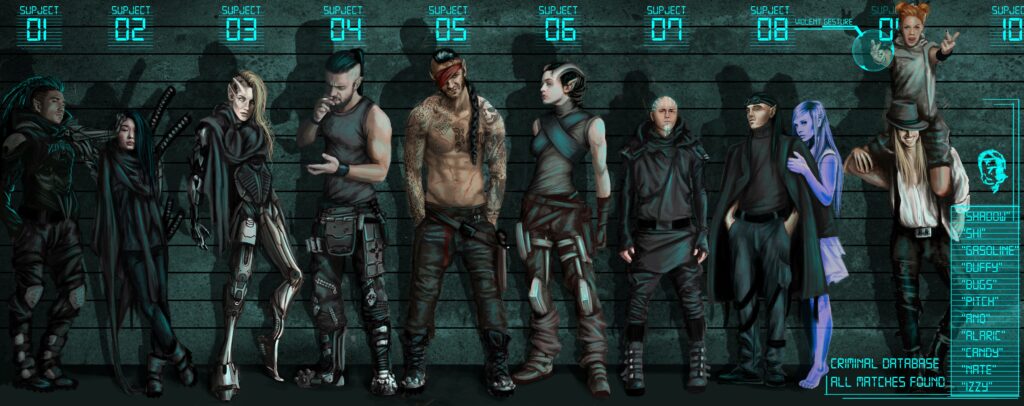
How did your group meet up? How often do you play? What are your sessions like?
I have known Bowynn, Krysa’s player and Kwaba, Robot Jones’ player, for an exceedingly long time, I think it’s going on thirty years now. We’ve played SR since Third Edition. It seems like I have known Nomad’s player all of his life 😉 It’s sorta my fault he got into gaming, after all. Twitch and Little Doll’s players, I met through my wife. She met them on the Amtguard field, and introduced them to me and we tried out gaming with D&D for a while, then i finally had to start them playing Shadowrun. I seduced my wife into the dark side of Shadowrun shortly after we met, and I think that she fell in love with the game just as much as she did with me, lol.
We have been playing weekly together for a while now, with game night settling on Tuesdays. My wife and I have been travelling a lot for her job as an RN, so there’s been a lot of play through voice calls on Messenger for a while. Since I recently settled into a new job a few months ago, I’ve been more localized to our house and our in-person gaming has resumed.
Our sessions can usually be boiled down to one word, lol. Chaotic! If you know, you know…
You have a very innovative Navigation System on your site. What inspired you? How did you go about setting it up? What advice can you give for new GMs on Obsidian Portal who want to do the same?
Really, I have to give a lot of props to the site’s design here. It gives the opportunity for Ascendent
members to edit, add, remove, and modify the navbar to their heart’s content if they wish. And I speak only for myself here, but it is a GREAT feature that I was super enthusiastic about when it came up.
I was particularly intrigued by the way you extended your Experience Point Awards to cover three different sections – Heat, Reputation and Karma. I know you also had this on your previous award-winning site, “Wildside”, but what inspired this, and in what way does it help you and your players?
Karma is the real “experience point” value among the three here, although all three are earned by characters in Shadowrun through play. Reputation is how well-known a character becomes among other groups of the world by their actions in-game – its not always positive, either! And Heat measures how much characters have screwed up and both how well-known among and how wanted by the authorities a Shadowrunner has become. The lower the better there 😉
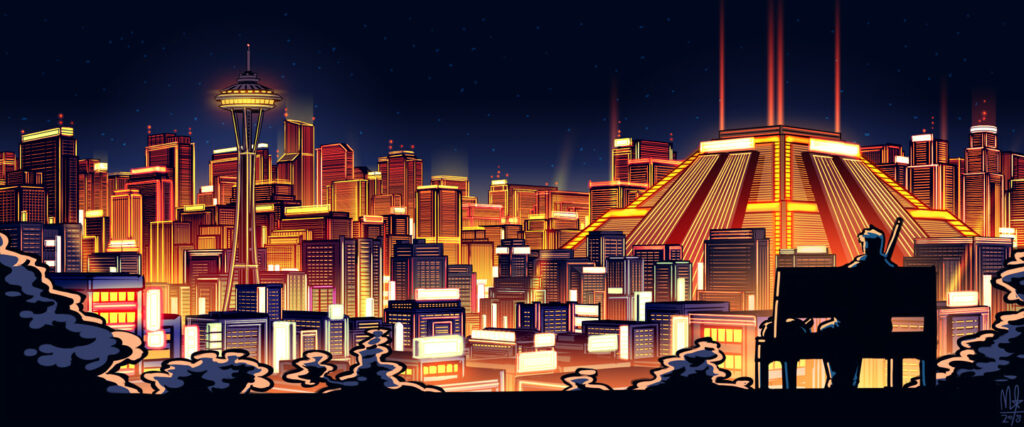
Your “Critters” section is very cool. Which ones have been the most memorable in your game so far? And DO tell us more about the “Drop Bear”…
A lot of the threats a character will run into are human in Shadowrun, but there are other… things out there as well. In Shadowrun, these critters are normal animals that have changed somewhat due to the influx of magical energy into the Sixth World over the seventy-some-odd years of the alternate history. I wanted to build a section for my players to be able to see some of these things and reference rumor of their various capabilities. Most of the time, I add to the critter section before one is potentially encountered.
Well, the Drop Bear is kind of exactly what is described in the Critters section. An awakened koala with very sharp teeth and claws that fall off of trees to drop on their unsuspecting prey – which often tend to be humans! The group has managed to find one of these critters well outside of its native habitat that was subjected to a variety of experimentation in a corporate lab. Ringpop, the resident animal lover, has ended up sort of adopting it and is trying hard to tame it and teach it tricks. She named it Tater Tot. She gets a lot of static from the rest of group because of that…
How involved are your players in the site? Who tends to do what? Do your players add their own Adventure Logs?
The player of Little Doll, the group’s social butterfly and face, tends to post the bigger updates on the Adventure Logs from her character’s perspective about all of the goings-on. When other players are able, they have added to the Adventure Logs as well.
I tend to use the site as a whole as a reference and tracker for our game, and the Adventure Logs to post contacts reaching out to various members of the group to set up jobs, or to frame events that occur in the world that are outside of the characters’ spheres of influence but might affect them in some way.

How long have you been using Obsidian Portal? What brought you to the site and what keeps bringing you back?
I have been using OP since 2009. I had been looking for a campaign journal site, and I really enjoyed the features OP offered a lot. What keeps me there is the fact that they are so devoted to continually improving the experience of use and site utility, and the community built up around the site that is so supportive among the users.
If you had to pick just one thing, what would you say Obsidian Portal helps you with the most?
I would say that Obsidian Portal is awesome for giving me the means to keep my campaigns’ details
organized, cataloged, and documented. And it allows me to customize so much of the way I would like to do that.
What would you say is the biggest highlight of your game so far (please also provide images and links if possible)?
Little Doll and Nomad say that Tater Tot (https://morethingsinheavenandearth.obsidianportal.com/characters/drop-bear) is the highlight of the game 😀
Ringpop says it was the time her character got stuck in Dante’s Inferno and was singled out by Dion (https://morethingsinheavenandearth.obsidianportal.com/characters/dion), the lead singer of Thursus (https://morethingsinheavenandearth.obsidianportal.com/characters/thursos), for romantic overtures only to find out that he is actually a dragon! She ran so fast… Ringpop does not like dragons at all, they make her very nervous and she already has a difficult time in social environments.

Okay, as a last question, we always ask for the GM’s “pearls of wisdom”. What GM insights can you offer the community this month?
In Shadowrun especially, if you can set up paranoia, do it! Use what the players tell you about their perceptions of what’s going on to feed the flames. Don’t always confirm what they say, but do confirm enough to make them feel what they are thinking is right before you introduce a twist and pull their rugs out from under them.
Always keep pressure on the characters, keep them hungry, use external organizations to push them and show them the sharks swimming alongside them, and give them enough rope to hang themselves.
Be sure to reward them well when they pull off something ingenious, give their characters’ actions, relationships, and personal motivations weight, and make them matter in the world at large.
And last, but, not least, if they decide to take on an MCT Zero-Zone, go hard. Make them work.

Thank you to the community for making this campaign of the month possible! That’s all for now, join us on our next adventure February 1st, and don’t forget to nominate your favorite campaigns for our next Campaign of the Month!
OBSIDIAN PORTAL CAMPAIGN OF THE YEAR 2023!

WINNERS FOR 2023:
First Place: Elvathadrin with Torg: Rise of the Storm Knights
Runner Up: Lord_Sam with Esomor Prime
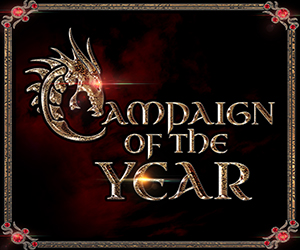
It’s that time of year again- you guessed it, it’s Obsidian Portal’s Campaign of the Year 2023! It’s the ultimate showdown between some of the best of the best Obsidian Portal has to offer: The winners of our Campaign of the Month 2023! Voting is open to anyone who wishes to contribute- be sure to keep an eye out on the OP Community Forums, the OP BLOG, Facebook and Twitter for more information!
We have some great prizes in store for both the first place winner and our first runner up! In addition to winning Free Ascendant membership time, this year we have some AMAZING prizes generously donated from some of the best in the industry, including Paizo, Frog God Games, Limitless Adventures, Crit Academy and Mongoose Publishing!
FIRST PRIZE includes:
– Digital copies of both Starfinder and Pathfinder Second Edition Beginner Boxes and/or Core Rulebooks from Paizo,
– Physical copies of Traveller Core Rulebook and the Paranoia Core Book from Mongoose Publishing,
– Digital copies of Limitless Encounters 1, Limitless NPCs 1 and Limitless Monsters 1 from Limitless Adventures,
– A gift certificate worth $200 to select any digital items in store from Frog God Games,
– Physical copies of Bountiful Bounties and Aelx’s Bombastic Oddities from Crit Academy,
– 1 Year Ascendant Membership from Obsidian Portal
RUNNER UP PRIZE includes:
– A gift certificate worth $100 to select any digital items in store from Frog God Games
– 1 Year Ascendant Membership from Obsidian Portal
A huge thank you to our sponsors for this years prizes!:
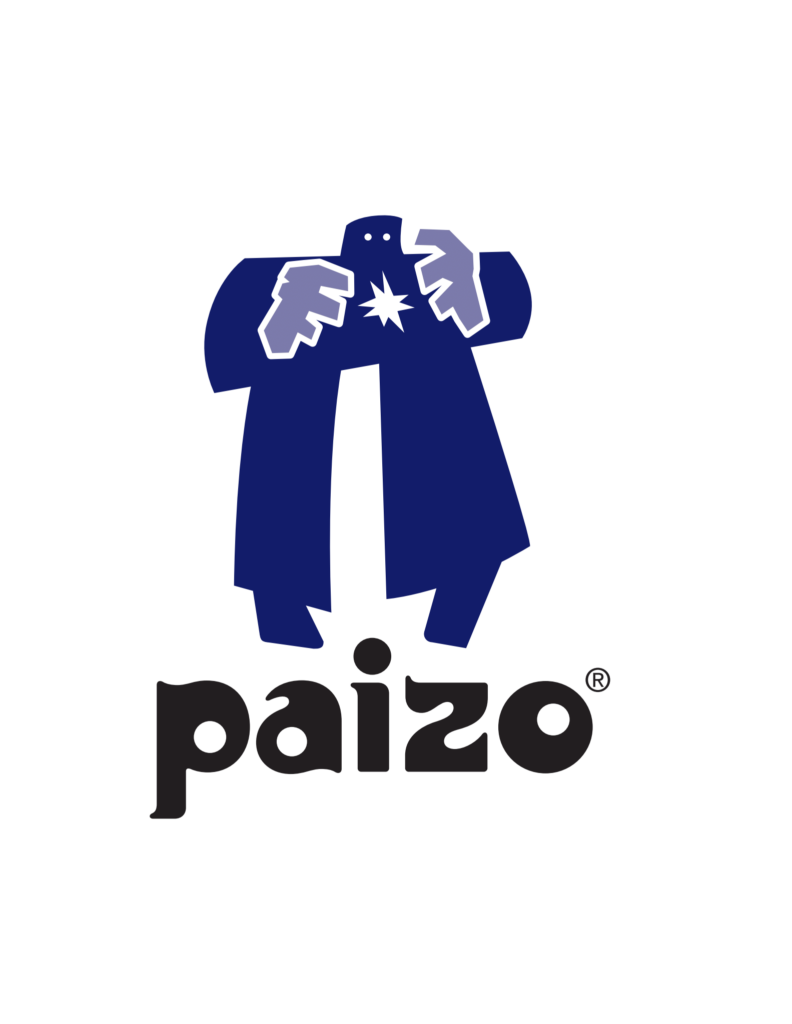
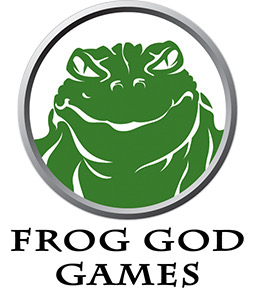

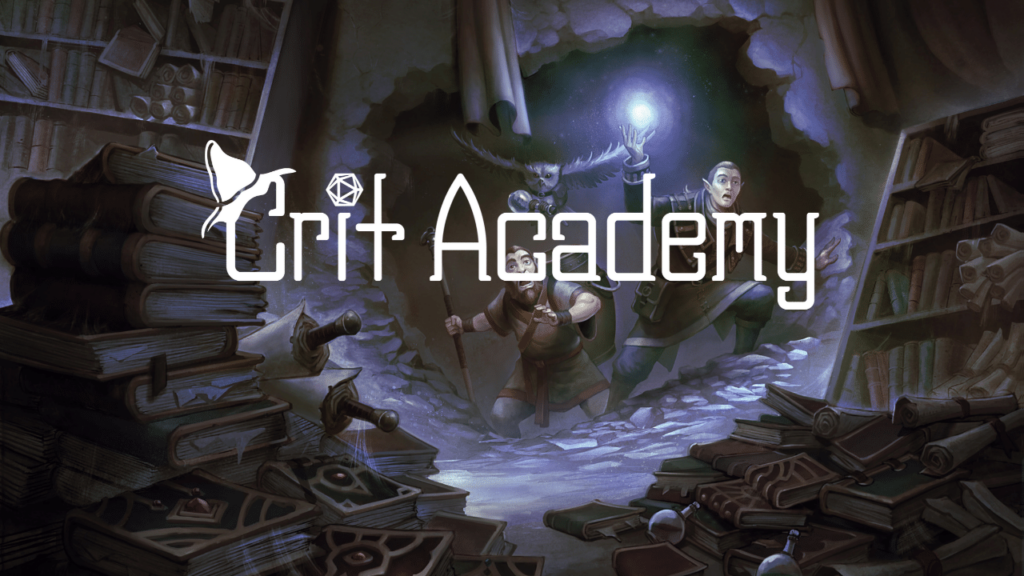

Creator Spotlight | An Interview with The Furtive Goblin and The Lawful Neutral (Bridgetown)
In the realm of tabletop roleplaying games, few settings capture the unique blend of pastoral charm and liminal unease as effectively as Bridgetown from Technical Grimoire. This never-ending, ever-crumbling bridge straddling the boundaries between realms has become a popular destination for adventurers seeking a taste of the extraordinary.
Behind the imaginative tapestry of Bridgetown lies a team of creative minds who have poured their passion and expertise into crafting this enchanting world. We had the privilege of interviewing the Lead Writers of Bridgetown – The Furtive Goblin and The Lawful Neutral (John Gregory) – to delve into their inspirations, design philosophies, and hopes for the future of Bridgetown.
In this interview, we’ll explore the genesis of Bridgetown, the unique challenges of designing a setting that defies conventional boundaries, and the team’s vision for the game’s future. Prepare to embark on a journey through the ever-shifting landscapes of Bridgetown, where the ordinary meets the extraordinary, and the boundaries between worlds are as fluid as the river that flows beneath the ever-present bridge.
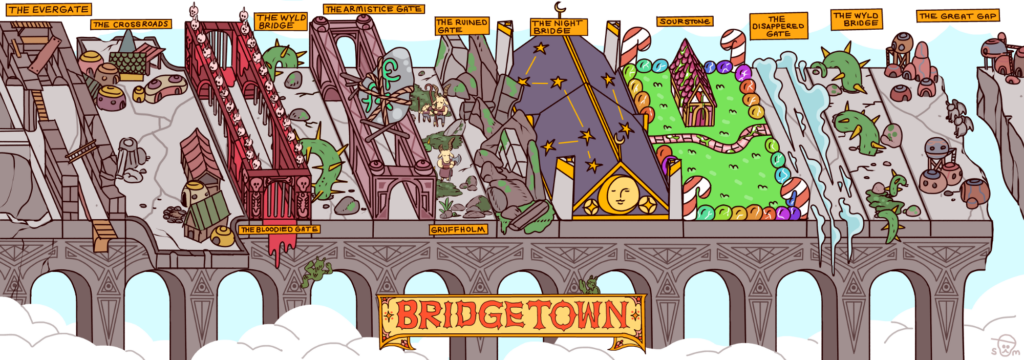
What makes Bridgetown different from other TTRPGs?
Bridgetown is a campaign setting for Troika! which seeks to exchange its default gonzo science-fantasy flavor for something different. It’s a game set in an impossible location–a never-ending Bridge–that is caught somewhere in between rustic folklore, Boschian fever dream, and dystopian punk, with a little sprinkle of hobo culture for good measure.
The Furtive Goblin
Bridgetown is a setting and resource book that goes along with the very inspiring Troika! system, which itself was inspired by old school Fighting Fantasy. Troika! overall has done an amazing job at inspiring weird and psychedelic settings that range from science-fantasy to cottagecore to genres I’ve not even got a name for. Bridgetown itself is what we’re calling a Liminal Pastoral setting–somewhere between wandering across Ghibli landscapes, living on Old London Bridge, and being stuck in The Backrooms. It is a weird world caught between infinities on every side, yet it is homey.
The Lawful Neutral
What are some of the challenges you faced while designing Bridgetown?
We (TLN and I) had a lot of ideas to start off. We spent almost an entire week just doing an idea jam while looking up images of old medieval bridges. Way too many ideas to fit into a single product and still get away with calling it a zine. We had to hone our focus to be more narrow and bridge-like. Fortunately, our team was way better at making us do that than we were at first.
The Furtive Goblin
Really, once Furtive Goblin and I got onto the Bridgetown writing train, the main challenge was knowing when to stop. We came to David/Technical Grimoire with pages and pages of ideas for what was originally going to be a little twenty page zine. With the help of David giving us reasonable restrictions and Hannah, our editor, taming our writing, we were able to go from a complete mess of materials to an actual functional Bridge(town.) That all said, another part that we considered a design challenge was “How do we make a setting interesting that is literally only 50 people wide East/West and infinite North/South?” We thought that it could feel constricting or railroad-y, but our playtesters really felt like the space restrictions actually made for interesting challenges and gave them a good impetus for continuing to journey onward.
The Lawful Neutral
How did you playtest Bridgetown?
TLN and I took a hands-off approach to playtesting, and let David run several games with playtesters that he organized. This ensured there was little to no influence from us as the writers on how the players interpreted the text. It also led David to make some really fun and interesting calls as a referee that helped shape how the rest of Bridgetown was written, alongside all the player feedback we received.
The Furtive Goblin
Our playtesting was done by a combination of several very fun sessions run by David as well as a pair of live plays on Twitch! Instead of personally running or playing in it ourselves, Furtive Goblin and I listened in on the sessions and paid attention to what did and didn’t work, what folks were excited about, and where we could tweak parts to be more clear. One of the major changes to come out of it was the original fundamental premise. We had planned for folks to be playing a character that is ultimately looking for a place to settle down and make their Home, allowing the character to retire and someone new from the location to adventure from there. However our playtesters had so much fun with their initial characters that they simply wished to keep on journeying!
The Lawful Neutral
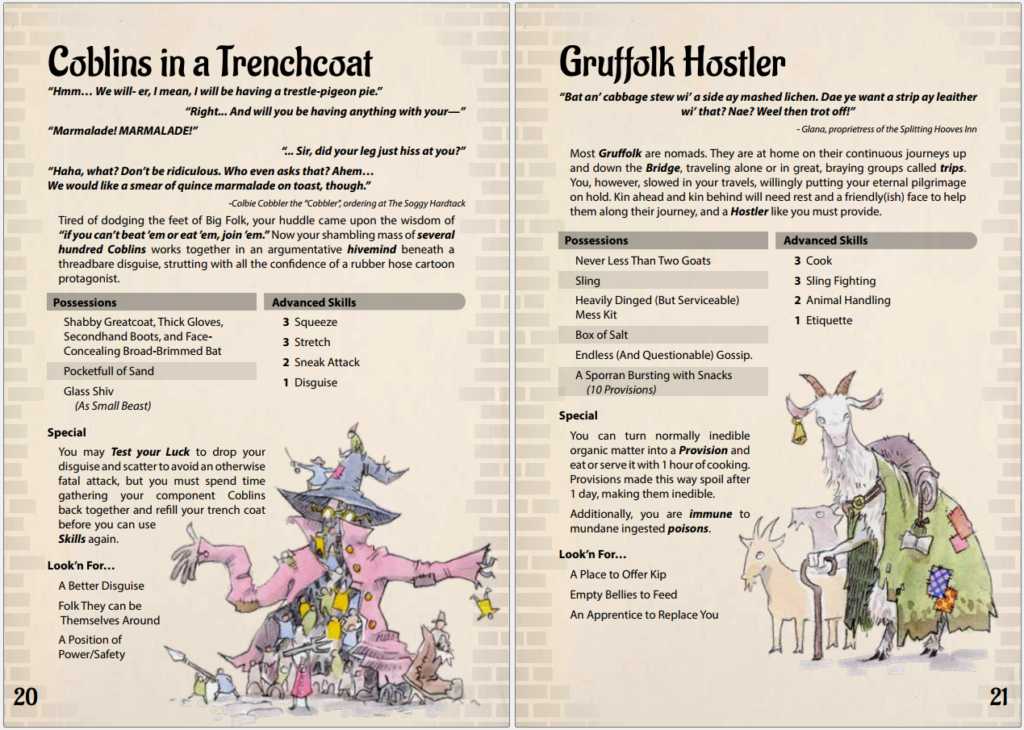
What are some of your favorite features of Bridgetown?
The “Weather” table including flocks of awful birds dropping feces like a hailstorm is definitely a crowning achievement of Bridgetown, and gaming in general. In seriousness though, I love that we managed to build a sort of natural ecology into the Bridge, with all the critters and weirdos that entails. The book has some of my favorite backgrounds in all of Troika! Ghost hivemind golems (Stone Keenings) and Brummie-accented sewer trolls are pretty high up there.
The Furtive Goblin
The certainly colorful locations and NPCs, many of whom are inspired by our own personal game experiences. Each span and district of the Bridge has its own unique flavor which we hope is inspiring to anyone who decides to walk it. You could take pretty much any setting or genre, mix it with a little weird, and set it down onto the Bridge. And if you ever get tired of it, all you have to do is jump off the side and see what strange new world you land in!
The Lawful Neutral
What are your hopes for the future of Bridgetown?
I can realistically see us working on Bridgetown for a few more years, whether it’s in the form of adventures or fun new ideas for backgrounds and locations. One early idea we put on hold was designing a Bridge generator that you can use to create randomized districts filled with events, landmarks, etc. on the fly. We went with individually crafted locations instead, and I think that was vital to nailing the themes and atmosphere of Bridgetown. But I still think that generator would be the perfect capstone for the IP, as a way of giving it over to the players once we’ve said our piece. As endless as the Bridge is, I don’t think we’ll be churning out endless amounts of content. It needs to be allowed to breathe.
The Furtive Goblin
Furtive Goblin and I are still writing more and more for it and we think it would be great fun to have expansion zines come out for it over time. I’d personally love to hear from folks about any sessions they run and how they put their own unique spins on it. One of the ideas we were not able to fit fully into the book but we encourage people to consider– each of the infinitely tall Piles/Pillars that the Bridge sits on could be hollowed out to throw any dungeon you might want in there. We might get out something in the near future giving some fun examples for this.
The Lawful Neutral
Can you talk about the pastoral and liminal aspects of Bridgetown?
“Pastoral” as a concept is a huge beast that encompasses thousands of years of literature, poetry, and music, but for Bridgetown we used it in the sense of the idealization of the rustic and the rural; the shepherd wandering with their flock. It kind of takes a sarcastic or ironic bent here, because the Bridge is anything but cozy and rural. It is literally liminal, in that a bridge is a thing meant to connect two locations that don’t exist in this scenario. But it’s also liminal in the sense of a lack of belonging. It’s a game of punks and wanderers looking for something that their tiny sliver of infinity didn’t provide them.
The Furtive Goblin
Take the story of the Billy Goats Gruff. On one side there are the barren hills from which our three Goats come from and on the other are the heavenly Fat Pastures that they wish to reach. In between there is a bridge and a troll. This is an idealized pastoral landscape that the Billy Goats live in, but the story takes place on a bridge–a liminal place that is neither here nor there, it is the place in between here and there. In Bridgetown, the Bridge is all there is. The Bridge and the promise of the Fat Pastures. It is where the hope of a rural but uncomplicate life is shadowed by this strange, unforgiving landscape where people of all walks survive the best they can. There is probably some sort of allegory for Purgatory in there if someone wanted to run with that.
The Lawful Neutral
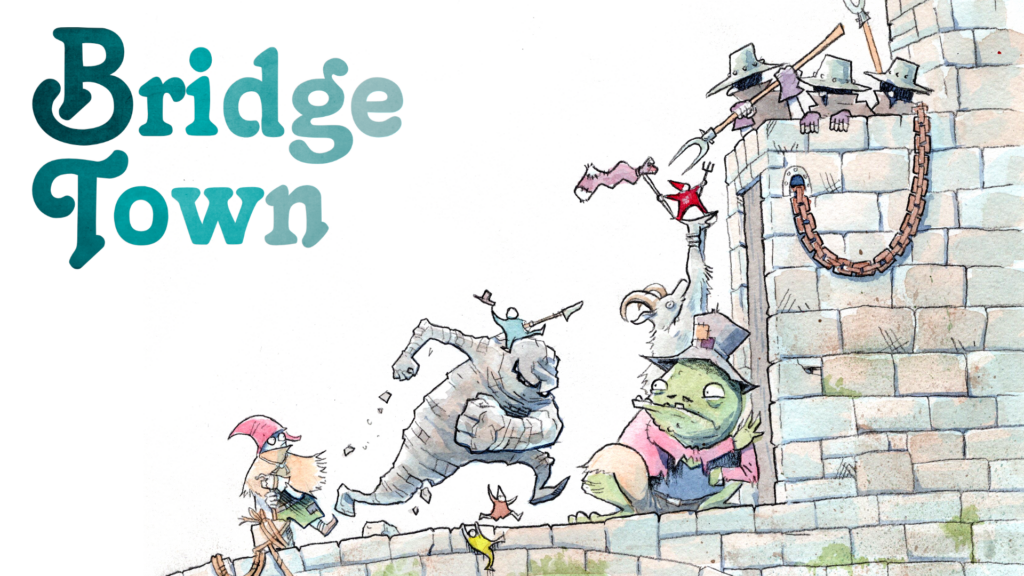
How does the provisions-based economy work in Bridgetown?
Food-as-money is one of many ways business can be conducted on the Bridge. Commerce inside a neighborhood is as simple as hashing out agreements and giving gifts between people you’ve known your whole life, but anywhere else on the Bridge you’re a stranger whose word is only as good as the goods and skills you possess. And no matter where you go, everybody needs to eat (except maybe Stone Keenings). So provisions are an obvious and practical medium for trade, with the added bonus of not having to deal with turnpike guilds.
The Furtive Goblin
When your world has a 50-man wide boundary, you have to make due as much as possible with the space and resources you have for there is scarcity everywhere. The Tower Aristocrats and the Turnpike Guild try to impose local currencies–but these are more or less like the script that mining companies imposed, useless outside of their immediately controlled areas. And so the name of inter-district trade is all about bartering. Iron from the Cable Mines traded for produce from The Squeeze, artifacts pulled up from The Great Excavation traded for clean water sourced from the Wyld Bridge. Among the motley folks who call the Bridge home, needs often outweigh wants so a loaf of good gitless bread can get you a long way.
The Lawful Neutral
What are some examples of Keystone Spells and Troll-Croak magic?
The magic wielded by Stonewrights–basically stonemason wizards–pulls latent energy out of the Bridge and the stone that constitutes it. Thus they require magical keystones to power their spells. Do this too recklessly, and the Bridge begins to erode and fall apart around you. A perfect example of this is Stone to Soil, which turns rock into dirt- ideally for gardening, but nefarious uses exist too. Troll magic comes from the gut, so to speak. Their spells cost Stamina like in classic Troika!, and reflect the ancient shamanic traditions of the sewer trolls. An example is Inoculate, which renders someone immune to a single disease- handy to have when you spend so much time in sewer water.
The Furtive Goblin
So the biggest differences between the two types of magic here is who uses it. Stonewrights are, by and large, humans who use the energy of the Bridge itself to cast their magics–they bend and manipulate the natural forces of the bridge to their whims. This is why some are Bolsterers, who work to maintain a balance and preserve the Bridge, and some are Eroders, who siphon magic from the Bridge without thought of consequence. When a human dies, their soul is often interred into Keystones to preserve the magical energy of the Bridge itself. A very basic Stonewright spell is Word on the Street, where they essentially commune with the Bridge itself for the local gossip. Trolls, on the other hand, are connected body and soul to the Bridge without the need of Keystones–when they pass away they turn back to the stone from which they were born. Thus, their magic comes from within, allowing their croaking songs channel the Bridge through them directly. A very direct example is Yaulp, which takes the echoing nature of the Bridge’s sewers and amplifies it into a concussive shout that can be heard a mile away.
The Lawful Neutral
What are some of the weirdest birds and weather events in Bridgetown?
Scrapper Herons are four-eyed nightmares with serrated beaks that can rip through metal. You don’t want to be well-armed when one of those starts building a nest. You can’t get much weirder than Under-Things on the Bridge. The Under is a soup of cloudy, rarified reality that the Bridge sits on top of, and once in a while it belches forth Things made out of roiling matter and concept. They’re childlike and curious about the Bridge, which is bad news when their mere presence can kill you or drive you batty. My favorite is the Slavering Under-Thing that understands through taste, and leaves a lot of scandalized Bridgers in its wake.
The Furtive Goblin
My favorite bird is Bosch’s Echo-Babbler, a massive bird hiding in its thick shell and using it to crush unwary targets then slurp them up with an elephantine hummingbird tongue–but that’s the beauty of the Awful Birds. Look at some Bosch or some Zdzisław Beksiński then combine it with a bird and you’ve got yourself an Awful Bird for any scenario. The Weather on the Bridge is more like “Whether” whether we’re going to have rain or a few hundred mouse-sized Coblins paragliding down to stab and steal. While the table of Spells run amok is really absolutely fun, my personal favorite Weather is this: “Scent of Home: A wind blows, carrying with it a smell somehow both unfamiliar and nostalgic, a sweet promise of new beginnings and old dreams fulfilled. A wind like this blew the day you left home.”
The Lawful Neutral

Can you tell us more about the Stone Soup Campaign?
Despite being an introductory quest, Stone Soup was one of the last things we added during development. It’s more TLN’s baby than mine, which makes sense since he’s already worked on at least one other food RPG, Gourmet Street. Stone Soup is essentially a road trip where your map is a list of esoteric recipes and abstract ingredients for the bizarre stuff you can cook up using this totally-not-horribly-cursed cauldron with a magical keystone embedded in it.
The Furtive Goblin
Stone soup arose out of a need to tie everything together and give folks a sort of impetus for travel if they didn’t already have one. There is nothing like giving folks a powerful, strange, non-completely-understood magical item from day one and telling them to run with it. It also encourages folks to look around at everything they encounter in Bridgetown, consider what might be an ingredient, what might hold deeper metaphysical meaning/power. A major inspiration for what counted as ingredients in Stone Soup came from Gleipnir, the rope that binds Fenrir. The Breath of Fish, the sound of a Cat’s footfall, the roots of mountains etc.So those mushrooms that the Troll Sewer Working is carrying is an ingredient, but so too could be the secret name of the Undercrone or the passed along memory of the taste of the Candy-Cobbled Streets.
The Lawful Neutral
What do you think makes Bridgetown a good TTRPG for one-shots?
The Bridge is divided up into locations and gatehouses that each offer a unique feel and plenty of fuel for referees. You could blow through a whole town or a dungeon in a single session this way, if you want them to be bit-sized. You can also build the Bridge “tall” and put way more emphasis on a single place for multiple sessions. Or you could get so absorbed in a single event or NPC that that spirals out into an unexpected emergent story that then dominates the entire session, as our playtesters managed to do a few times!
The Furtive Goblin
Bridgetown is not only great for one shots because our awesome publisher literally made a free One Shot generating resource on his website, but the very distinctive flavor of each district makes it very easy to move from set piece to set piece without significant travel times or lead up normally involved in a large campaign. In the playtests we were generally able to get through three to four districts in a single session–but at the same time there is enough happening in each district that one could spend multiple sessions in a single one if the referee and the players feel so inclined.
The Lawful Neutral
What advice would you give to someone who is new to Bridgetown?
Embrace that feeling of being a drifter who rolls into town and shakes everything up a little. Give yourself over to whimsy, and see where your feet wind up taking you. It’s an endless world out there, and one place is just as good as the next.
The Furtive Goblin
Have fun with it and go with the flow. Bridgetown isn’t necessarily about a specific victory condition, it isn’t necessarily about defeating monsters or gaining treasure. Bridgetown is about enjoying the journey and living the world, it is about trolls who want fair working conditions and nomadic goatfolk for whom life is an eternal pilgrimage. It is about tiny boschian goblin-things who alternately want to stab big folks and live comfortably inside their walls. It is about being a ten foot tall rock monster who wants, more than anything else, to find a place to truly rest. In short, it is the same advice I’d give to any player–play the world.
The Lawful Neutral
What’s the most creative thing you’ve seen a player or GM do with Bridgetown?
Early on in the playtest, our Stone Keening character effectively no-selled a potentially very hairy encounter by absorbing an angry, out-of-control magical experiment into itself, giving the spirits the experiment was made out of a chance to cool down in a safe space. It also had the side benefit of righteously pissing off the mad doctor who was behind it.
The Furtive Goblin
In one of my favorite playtests a group of Coblins and a Stone Keening worked together to bind, rejuvenate and give a sort of metaphysical birth to long lost souls using their combined connections with the Bridge and interactions with a particular strange stone you’ll find in Craterton. But that is only one of a dozen such stories I could tell about how we’ve seen players take our basic prompts and turn them into so so much more.
The Lawful Neutral
What might fans look forward to in the future from you?
More Bridgetown! It might take a while to get a sequel/extension book squared away, but the team plans to have another Bridgetown book out sometime next year. We left way too many neat ideas on the cutting room floor not to. As for me personally, I am mostly focusing on my blog and the occasional book contribution or playtest.
The Furtive Goblin
I am right now between books so I’m largely self producing mini generator zines for folks to have fun with. Magical Miscreants, a Witch/Wizard generator, and Gobs Galore, a goblin generator, are my latest ones on Itch. However, Furtive Goblin and I hope to produce more Bridgetown content with Technical Grimore in 2024 as well as getting our greedy writing fingers into some more projects. Keep an eye out!
The Lawful Neutral
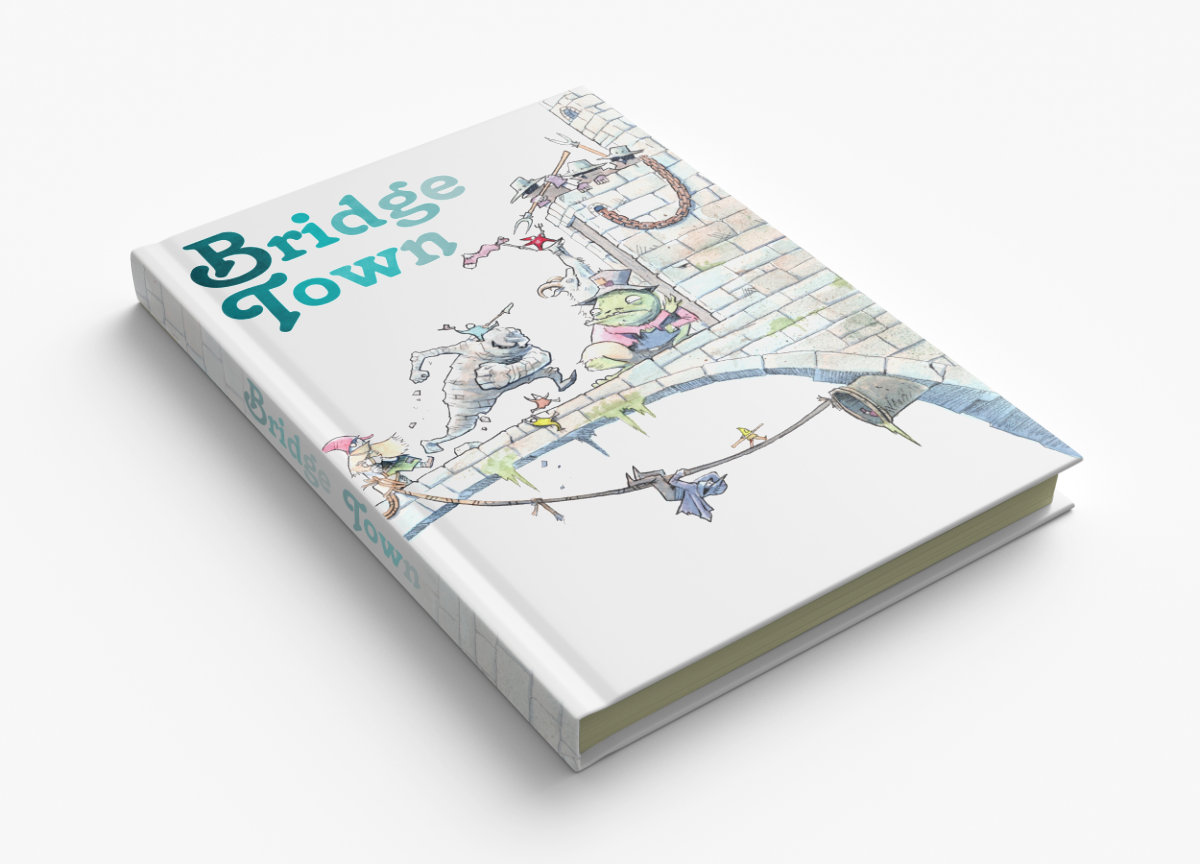
You can find more about Technical Grimoire on their website, Twitter, Facebook, Instagram, or Discord. The Furtive Goblin and The Lawful Neutral can both be found on Twitter.
Obsidian Portal Campaign of the Month November 2023: Violet Hill
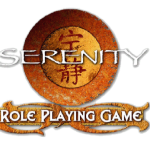
Saddle up, Browncoats, and take a gander at the goods in this November’s Campaign of the Month — Violet Hill, by Jonathonathon. It’s a veritable ‘Verse of slick design, custom rule-mechanics, and unique Firefly/Serenity storylines developed over many iterations by a husband-and-wife team and it’s just plumb pretty. Fire it up and let’s get this bird in the air!

Salutations, Jonathonathon and congratulations to you and your gaming group on winning Campaign of the Month! Please tell us a little about yourself, how you found your way into roleplaying games, and how your group found each other?
Thank you! I’m really excited you guys took notice of the campaign and selected me! Sorry the site isn’t mobile friendly, my most recent ones will be through!
A little about me: I’m Jonathon and when I’m not scribbling game notes I work my day job as an eCommerce manager. I’m an omnichannel digital marketer but mostly specialize in analytics. I found my way into tabletop games in college when I worked at a grocery store. While I was working a register for my shift, my coworker pulled out a Players Handbook for D&D 3.0 and I started asking questions. Eventually she invited me to a game and that was my first experience with a ttrpg.
My current (and only) PC is my wife, and we actually met because of gaming. I ran into her then-boyfriend on our college campus one day when I was late to class and we chatted for a few minutes. He briefly mentioned a game he was running and asked if I was interested, so I showed up and joined his group where we met. It was a BESM game set in the Outlaw Star universe.
I used to have a pretty regular group for a while but we all grew apart, so mostly I just run games for my wife now. We try to get in a session on weekends when we can scrape together a few hours. Unfortunately it’s tough to bring in more people with an inconsistent schedule and heavily homebrewed mechanics.
Your campaign, “Violet Hill” is set in the universe of the Firefly TV series, using the Serenity RPG mechanics. Could you give us a few, brief highlights for those unfamiliar with the setting and game system?
Sure. We use the old Cortex system, not the most recent and probably more widely known Cortex Prime. The system uses a die rating of d2 through d12 and every trait in the game can be measured on that scale (with the exception of Assets until an alternate version of the system was released in a later publication called Big Damn Heroes). What we love about Cortex is the plot point system. It rewards players for cool descriptions and ideas, and in turn they can use those plot points for things like minor story edits. I like the system because it actively encourages players to be more involved in the game. After you get to know the system, it’s also crazy easy to write and stat for.
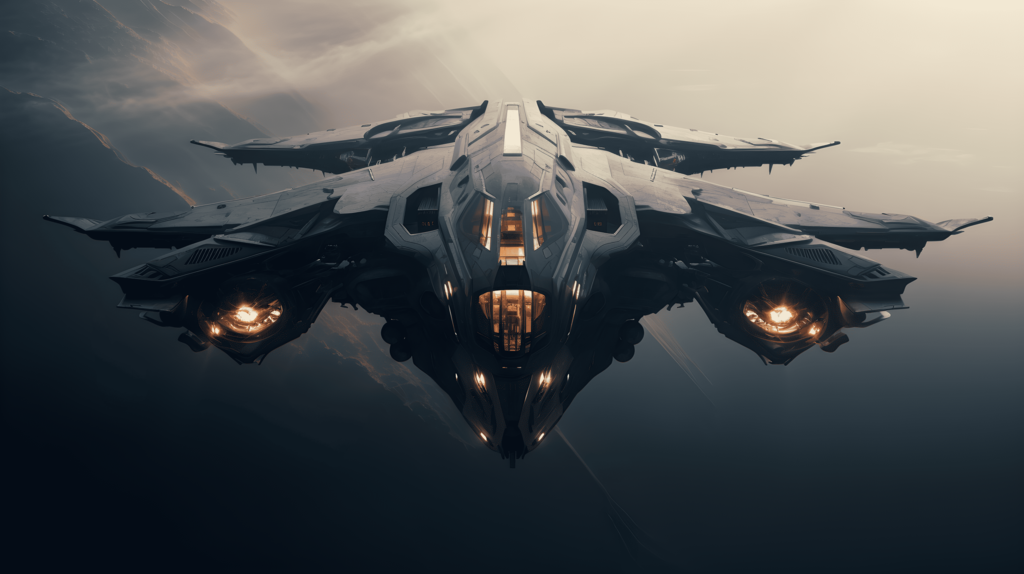
What’s the story of “Violet Hill,” so far?
We’ve run this campaign around half a dozen times now, so there’s quite a bit. We first played a pretty traditional Serenity game but I really like running high powered fantasy games. So I started working on a rule set to bring a high fantasy vibe into the world. Thus the “Red” game was born. It was the idea that the Alliance had released a compound which caused people to develop unique powers. The “Red” game ran through a few iterations of mostly super-hero-esque Serenity fun but my wife and I continued developing the story and iterating on the concept.
Eventually every color of the rainbow became its own mutation with unique attributes and the story of “Red” continued to evolve. My wife and I used to trade off running games and we would build on the cannon that we wrote with each successive game. Where we wound up with it is that Red is a fraction of the genetic material of an advanced alien race that the Alliance is trying to understand and control. The alien race that are the progenitors of the mutation have incredibly advanced abilities and technology but their motives have changed from campaign to campaign. At first they were just explorers that happened to accidentally get captured and experimented on.
In our most recent campaign, they’re a pacifist race being attacked by another conquering alien race but have embraced pacifism so completely and for so long they’ve long since lost the ability to defend themselves. Most of the race believe that if they can’t escape the alien invaders they should resign themselves to their fate, but a splinter faction searched the universe for an answer and found humanity. As we all know, humans have a long history of gruesome experience in war and were ideal candidates to fight back. So this small sprinter faction began implanting a small part of their genetic material to mutate humans in the hopes that they could rally an army just powerful enough to save their species. The campaign tells the story of the humans that have been drafted, their quest to overthrow the Alliance to unite humanity, and return to the home galaxy of their alien benefactors using their advanced technology to fight back the invaders.

The alien mutations mechanics described in “Violet Hill’s” wiki are very intriguing. Where did this idea come from and how has it played out, in-game?
Just the desire to bring a superhero/gritty fantasy element into the Serenity universe, although we began exploring the powers further with each campaign iteration. Early on the mutants were identifiable by their eye color which changed when they were exposed. It was a quick and easy photoshop effect we could apply to customize character pictures a little and give PCs bonus XP for. We took to just calling them by their color after that. Reds were superhero lights at first, then we developed different stages of mutations with more powers. After the Red campaigns we moved on to the color Violet. These mutants had higher highs than the Reds but more complications. A big part of their abilities were naturally forming hive-like structures which lent itself well to the crew-style game Serenity was based on. We also wrote custom assets to support this mechanic, further building on the system we’d already established.
The rules have lent themselves to some truly epic moments in game: saving a colony on the Rim that’s out of water by drawing it from nothing, growing biomechanical ships with technological capabilities far beyond what humanity has achieved, growing an additional organ off the brainstem to control an entire army of mutants directly, boarding ships by “jumping” onto them in the middle of intense space battles, and much more. It’s definitely a different tone and feel than the show but there’s still plenty of six shooters and swearing in mandarin to go around.
Your Obsidian Portal profile shows that you have been on the platform for quite a while and have experience with a wide variety of games. If you had to narrow it down, what would be some of your favorites and why?
Yeah I’ve been on OP for over 13 years now. OP was exactly what I was looking for since my games were moving from paper to the digital space unavoidably. At first I was a little resistant because I loved the pen and paper aspect of the hobby but practicality finally won out. OP is just such a convenient way to communicate with players and compile everything all in one place.
I love to try a little of everything, but I have a few stand-out campaigns that I really enjoyed and was inspired to run. I ran a Changeling: the Lost game about a girl who inherited a Goblin Market Stall from her grandmother and began acquiring supernatural powers through deals but was otherwise completely human. One of my wife’s favorite games was “Corporate Woman” which was run in Chronicles of Darkness, where she was a human that could wear supernatural templates like suits and used them to infiltrate different supernatural societies at the behest of a mysterious corporation run by an impossibly powerful administration. I’ve run a BESM game based on one of my favorite anime series, Soul Eater, which focused on a DWMA Meister and her journey through the academy. Adjacent to the Serenity system, I’ve run a Supernatural game where the players were supernatural creatures hunting other creatures that plays pretty similarly to Violet Hill. There’s quite a few, I like to bounce around a lot.
As for what’s next, I’m usually working on a few campaign ideas at any given time, but right now I’m writing a Pokemon Noir-style game inspired by the webcomic “Viridian City” (borrowing that name for the campaign) using the PTU system.

Do you or your players have any memorable moments, crazy twists, or favorite, Firefly-style quotes that were highlights during the campaign?
One of our campaigns involved a mercenary Captain with “Cold as the Black” but my wife, playing an Alliance-hating Rim folk girl, was set on bringing him out of his shell. They grew close over a dozen or so games until at one point they were planet side and her character was approached by a perfect duplicate of the Captain. The two of them merged back together (one of his abilities was that he could duplicate himself and never told her) because the original him was an Alliance Operative running interference for his clone and its crew. He had technically never met her before, but merging with his duplicate transferred all his memories and the Operative was pretty stunned by their relationship. She was pretty mad and it took a few sessions for her to forgive him, but they worked through it.
“Violet Hill” as well as some of your other campaigns, feature an innovative navigation interface with graphics that really help sell the themes and moods, as well as drawing attention to the information on which you want your players to focus. How did you create that layout and has it helped engage your players when they use the campaign site?
Wow thank you, that’s nice of you to say. I’ve got a pretty regular block of code I use to adjust the layout of the campaign then go into color schemas and particulars from there. I’m not all that great at coding and particularly terrible at anything art related, but I’ve been working a lot with MidJourney lately to create assets for my campaigns. It’s an amazing tool for GMs, I can’t tell you guys how much time I’ve saved from not having to comb through pictures for my games trying to find just the right one. It’s really streamlining how long it takes me to prepare. Viridian City is the first time I’ve incorporated layouts from MJ as well as assets to build a campaign, but it’s still very much a work in progress. Historically everyone that is in my campaigns is on desktop so that’s all I wrote code for but this time around I’m trying to make things more mobile friendly.

The setting lends itself well to just about anything — exploration, politics, ground combat, space combat, intrigue, heists, stealth missions, and good old-fashioned misbehavin’. What’s your favorite and what do your players like best?
My wife is all about relationships in games and lives for a great romance and getting to know the NPCs. I’m all about tactical encounters and creative problem solving. Our campaigns usually meet somewhere in the middle. Quippy dialogue and outrageous plans are also frequent additions, as the complication “Overconfident” is often responsible for a ton of plot points changing hands.
Obsidian Portal loves to hear the wisdom of winning GM’s. Do you have any tips or advice for writing stories, running games, building worlds, tweaking mechanics, or keeping the fun going that you’d like to share?
Find a way to make every game special. Most GMs I’ve met do that through story but I advocate for doing it in mechanics as well. When I run D&D games, I borrow a tradition from a friend of mine where he gives every player a wish to really customize their characters. It ensures each character is truly unique and something that no one has ever played before which we all loved. We evolved that into an “Ultra Point” system which allows players to buy up additional class features to really play a truly unique character by exponentially compounding character options. It’s also a great tool to round out a party for smaller groups as players started to drop off.
As you can probably tell from Violet Hill, I love to write custom mechanics to ramp up the campaign and then challenge myself to balance the game around them. I’ve known a lot of GMs that were staunchly against giving their players power and never understood why. I’d encourage GMs to let things get crazy from time to time. The more creative power you give your players, the more interesting solutions they’ll devise. The mechanics all come down to equations and probability, so it’s easy to let your players feel really powerful and still present a balanced (or challenging, or easy, or whatever you want) campaign to the table because everything else is under your control.
Lastly, and I know it’s probably been said to death but, one of my rules to live by is to play your way. It’s really discouraging to go to places like Reddit and other forums where “purists” believe games have to be played a certain way. If you have a great idea for a game you should go for it, and surround yourself with influences and people that inspire instead of criticize. Even if that’s not your cup of tea, when you read something from someone reaching out for inspiration to go a different direction than you would, be supportive instead of dismissive. What matters more than anything else is nurturing our passion for this hobby we all love.
Thank you for choosing Violet Hill as CotM for November!

Wellsir, it’s a mite late and the ol’ brainpan’s full of new know-how. So let’s call it a night with thanks to Jonathonathon on a bang-up job. Obsidian Portal is always looking for new nominations for Campaign of the Month, and you can submit your favorites here.
Also, keep an eye out for news on our Campaign of the Year competition, which is happening soon!
Update Post – October 20, 2023

Hail, Portal People!
The season clock has chimed again, so it’s time for another reckoning. See below for all of the new features and bug fixes that were added to OP since the previous Update Post.
If you have any questions, comments, or feedback, feel free to post them in the Community Forums, or email support directly at [email protected].
Obsidian Portal Campaign of the Month October 2023: Thieves & Kings
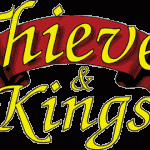
Well met and welcome to Argoth, the land of Thieves & Kings — our October Campaign of the Month winner! GM Robling is no stranger to our crown of conquerors, and adds to his accolades with some of the best world-building and writing you’ll read this side of the City of Bright Sails. Thieves & Kings has been many years in the making and promises to take adventurers from humble inns to fey courts to powerful portals into the realms beyond understanding. Warm your worn hands by the common room fire and listen to our tale…

What’s new in your life since your Campaign of the Month win in 2014 for “Battletech (Farscape): The New Breed”?
Practically nothing, though, fundamentally, COVID changed all our lives, neh?
“Thieves & Kings” has many chapters and hundreds of gaming sessions spanning seven years of real time. We know it would be impossible to sum up everything, but could you give us an overview of the story, so far?
Overview, hmmmm. It started with six players, each representing a character, who had been fostered for their youth to various clans across the realm of Shem, being informed their adopted father had died and left them his farm. They gathered and discussed matters, and were immediately involved in an assassination, and fled the town of Hexwater a few steps in front of the local law. Over the next few months, they established themselves in the region of Thornkeep, and discovered the local mystery around a troll invasion, the local fey creatures, and mistakenly (?) began hunting a former fey hag as their chief enemy. As the years progressed, they began to acquire divine powers and discovered that their former enemy “Blackmaw” wasn’t so bad, really, and that she was fighting someone who was far worse, “The Great Hunger”, her former lover. At present, the survivors have decided they wish to embrace these offers of divine power, and are sorting-out how to achieve true divinity as a Demi-God. But their enemy, The Great Hunger and his followers, know them and work to unravel their plans as they unravel his.
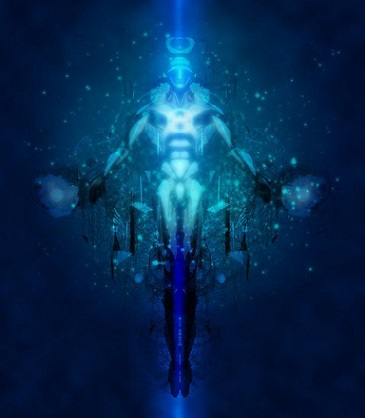
The continent of Argoth and the world of Kethira as a whole is extensively catalogued in your wiki — it’s a veritable library of information that has been built up since your school days. And the character section is absolutely full of people and stories. What were your favorite bits to write and what parts of the site do you find most useful?
It’s extensive because of the years of effort both I and my players have placed into it. The efforts of today’s campaign reflect in the campaigns to come, and that forms a very wide amount of information that never makes the WIKI or Portal files, but exists, nonetheless. The ability of the Obsidian Portal website allows a wide disbursement of information, including bios, stats and even connects them to items and other characters, because each has their own story to tell and share. I’ve found if you approach each NPC as a real person, and treat their reactions as real and honest from *their* point-of-view, it enriches the encounters with the players, and then influences future encounters.
At the end of the wiki for “Thieves & Kings” there is a section on customized rules for the campaign — many adapted from various supplements and systems and modified to fit your needs. The Rulership and Thieves’ Guild Operation rules were especially interesting. How have these worked out for you and your players during the game?
I established each for the players to read and decide which version they wished to implement for various campaign management operations. Most were discarded, as the group slipped away from large-scale management of armies and realms, and decided to concentrate on small, close-knit organizations of their own, dealing with dozens of people, rather than hundreds. The “Thieves’ Guild” operations remain important, as one of the players has worked to establish their control over the underworld of Mornhaven, and allows us to abstract that aspect of the game enough to concentrate more on the role-play and combat. Which was kinda the point of them, really.
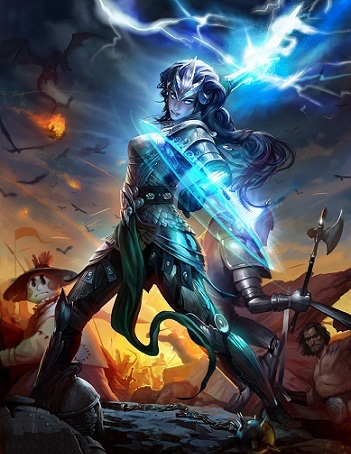
According to your Obsidian Portal bio, you have tried out many game systems and have a lot of experience with a variety of settings and game mechanics. From your perspective, what are the advantages and disadvantages of 5th Edition D&D compared to other games? Was shifting Argoth from other editions into 5th Ed. a challenge? Are there any plans to convert it into other systems in the future, if needed?
The advantage of 5th edition, I feel, is that it remains very robust in sliding back and forth between combat and role-playing, and allows exploration to be easily adapted to the encounters. If you compare it to early editions, it allows a great deal of mobility and movement to combat, which allows players to shine, rather than simply two characters beating on each other, whittling away HP as they go (*Cough Cough* 2nd Edition *Cough*). Pathfinder is nice, but too dependent on Prestige classes and Feats determining each encounter, whereas 5th Ed allows simpler math and makes the combat flow swiftly. I don’t think we’ll be transitioning into D&D One anytime soon, if ever, and the recent “home rules” introduced by Larian Studios “Baldur’s Gate 3” are intriguing and show how simple rules changes can make a difference in playstyle and encounters, and bears scrutiny.
The Adventure Logs for “Thieves & Kings” feature a clever format — a quotation, an inspiring image, and a video link to help set the mood. Are these atmospheric touches selected prior to a game session or afterward? Do you find that reinforcing the moods or themes during gameplay to be important or is it better to let the players create their own impressions?
I have found my players don’t typically pay much attention to them, until suddenly in the middle of an encounter they remember the title of the episode, or the picture, or the video, and it all falls into place in their minds. That’s the point of it, really, to hint a little and to provide some real physicality at a key part of the episode. Sometimes, however, they ignore it completely, and go out into left field, and the title proves irrelevant, as they choose to follow a new line of investigation from what they said they wanted to at the end of the last session. But that’s okay, because, ultimately the Players have the power, and choose where they want to go and what they want to accomplish. I simply provide options.
As to mood, I’ve found sometimes that you can lead the players to the encounter,and set the mood, but if they’re not into it, they won’t care. Sometimes they just want to chew gum and fight, and they forgot their gum.

What have been your favorite moments in the campaign, so far?
The sudden realization that one of the main characters, Blackmaw, wasn’t really so bad after all. She’s unabashedly NE, but they have accepted her as an ally, because she doesn’t see them as rivals, and sometimes they prove to be useful pawns to play. Her reveal of her love for her monstrous children to the party was especially precious, and one of the players said it was the highlight of the campaign to her. “Blackmaw” is my favorite NPC of all time.
Also the moment they were confronted with the knowledge there were actually seven children raised by their father, and they had another “sister”. At that point, they realized that the place they had been investigating was called “The Hall of Seven”; and they realized a truth they had known for months, but never clued into. Later, she swindled them to acquire a magical artifact with them, and during that reveal, they realized they’d been utterly taken advantage of, and never trusted anyone for a long time afterwards. They really didn’t like or trust her for a long time, though now they are openly working with her. “Skazzy” is a favored NPC this campaign.
Without giving too much away, what hints can you give us about the plans (if there are any) for the conclusion of the tales of “Thieves & Kings”? Or is this the kind of adventure that might go on for as long as possible?
The players know the ultimate goal of the campaign is to achieve demi-godhood, and the defeat of The Great Hunger. Only a couple of levels away from that, they understand their goal, and know that their characters are going to become demigods in the campaigns to come, so they have a vested interest in achieving this goal. Back when they gained their first “Divine Level”, they established the path of their cult, and its worship, and now it’s all about following-up with this to achieve their proclaimed status. We just started talking about what the next campaign might be…

During your first interview with Obsidian Portal for your prior Campaign of the Month win, you wisely advised GM’s to avoid being adversarial and to “Be the storyteller, and make the players the focus of the campaign.” In the years between then and now, what other insights have you gleaned regarding the craft of game-mastering, writing, and world-building?
Don’t plan too much. While I run an open-world campaign format, and for the most part, the players are quite willing to stay close to home. They really have so much to explore closeby, that they don’t *need* to travel much. Just have a couple of adventures handy that you know well and can adapt on the fly, and apply, whenever the players decide to “go rogue”. And they will go rogue on you in an open-world format. Otherwise keep plenty of notes so you can allow them to explore the world around them, and forge their own destiny. If you have notes from previous campaigns handy, they can travel over lands from previous campaigns, and realize what their previous characters have done, and how much effect their actions have at the moment and reaching into the future.
If you want the Players to travel, provide them with the means; Teleport Circles and Flying Boats (Spelljammer), or even just normal boats, allow them to travel extensively and explore across the worlds you design, and let them explore other genres of gaming, such as Oriental Adventures, Fallen Empire ruins and even isolated rocks in space at need, and give them a tie to the campaign world that they will treasure and love. In this campaign, they adore their flying ship, the “Emerald Angel”, improved their ability to get across the map quickly, rather than slogging across mountains for weeks, they can travel across the planet in days, or reach the markets at Mornhevan in a couple hours, rather than a couple days, making them able to concentrate on the task at hand, rather than the means to get there.
Otherwise, my campaign advice remains the same, keep it open-world, keep copious notes, and let the Players explore themselves as they explore your world, and they will develop the stories you will replay and talk about for decades.
Thus concludes our tale of Thieves & Kings, for now. Our thanks to Robling and his Players, once again, for sharing their creative might. Go forth now, fellow adventurers, with this edict: find us more worthy campaigns upon which to cast our eyes, so that our circle of judges may bring you fresh insights and inspirations. Bring your treasured discoveries to the forums, here.



